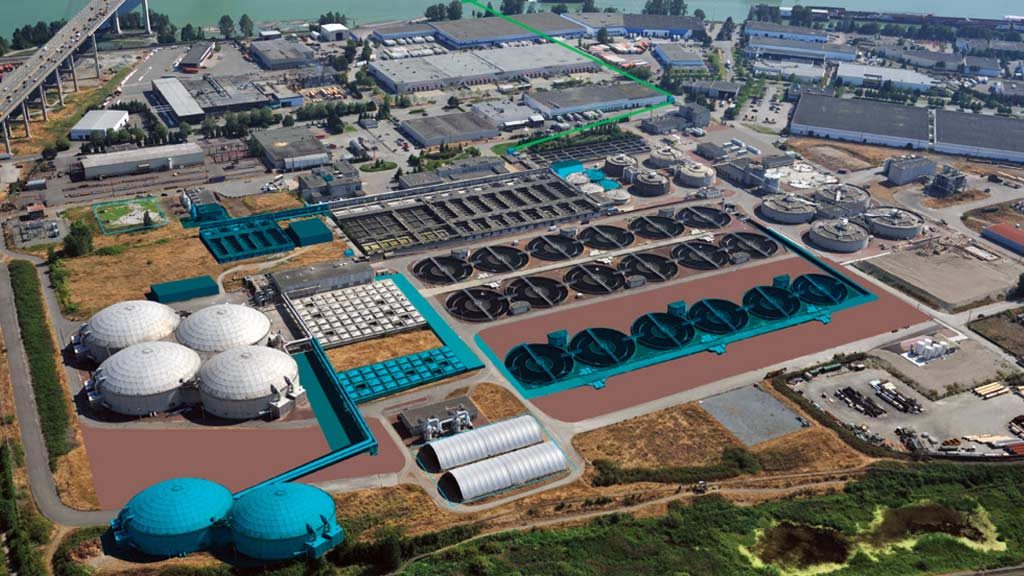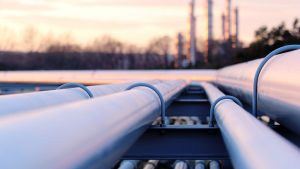A new, higher-capacity outfall and diffuser system is slated to be built over the next four years as part of a massive upgrade and expansion project at Annacis Island wastewater treatment plant in Delta, B.C.
The $184-million project involves constructing a one-kilometre-long tunnel about 40 metres below the surface that will extend from the existing plant to a shaft and diffuser valves in the Fraser River southeast of Vancouver.
A tunnel-boring machine (TBM) will be used to dig the underground route. Two vertical shafts will be built – one so the machine can be launched and another so it can be lifted when the tunnel is excavated.
Prep work to ready the site of the TBM launch shaft has been completed and an electrical substation was installed to power the machine. Part of an existing warehouse and building addition have been demolished.
Contract for the work was awarded to Pomerleau Inc. and Bessac by Metro Vancouver. The project is expected to be completed in 2024.
“Engineering design work investigated various options on how to discharge the plant effluent to the river, various outfall alignment routes, construction method, and modelling work to ensure the in-river diffuser design will meet the requirements of various government environmental agencies,” explains Jeff Chan, division manager – treatment plants in the liquid waste services division at Metro Vancouver.
“Permit approvals through Vancouver Fraser Port Authority are completed. Community engagement with First Nations, marine users and other stakeholders has been conducted and will be ongoing throughout construction.”
The new outfall location and design will ensure that treated effluent is spread out over a broad area underwater to maximize dilution and minimize the impact on the environment.
During construction, the shafts and tunnel will be excavated and the soil will be removed by large trucks. A cofferdam will be built from barges located about 100 metres offshore.
One of the vertical shafts will have an inside diameter of seven metres, the other 16 metres. One has been designed to be part of a future effluent pump station to discharge flow and counter the impact of rising river levels due to climate change.
Two precast, concrete-segmented tunnels with a minimum inside diameter of approximately four metres will be installed inside the tunnel – one 200 metres long and one 580 metres long – and will house the outfall pipe. The outfall pipe will discharge treated wastewater into the river.
“The new outfall will provide sufficient discharge capacity for the remaining future plant expansion phases with an expected lifespan of 100 years,” notes Chan. “No further outfall expansions should be required.”
The plant is one of the region’s largest wastewater treatment facilities. The facility already treats wastewater from 14 municipalities across the Lower Mainland so that it can be safely released back into the Fraser River. The improvements will allow the plant to significantly increase the volume of wastewater that can be treated and help keep odour to a minimum.
Work on the new outfall system will take place at the same time as a number of other ongoing projects, known as the Stage 5 Expansion. Currently, and over the next 10 years, roughly $1.9 billion in capital investment will be built at the plant. There are about 20 projects on the go or that have been completed. Stage 5 and the outfall project are required to increase treatment capacity to serve a growing population.
Chan says there are some construction challenges associated with the outfall project, but risk has been minimized because mitigation measures were priced competitively during the procurement process.
“During construction, challenges include unknown field conditions during the tunnel-boring, and the in-river work … installing the river riser for the diffuser within very short construction windows over two to three seasons.”
As per the B.C. Building Code, all work at the plant is also being designed to withstand the impacts of a substantial earthquake.
Chan says the ground under new structures has been densified with more than 5,000 stone columns to minimize the effects of liquefaction, horizontal movement and settlement due to an earthquake and the Stage 5 and newer portions of the plant will be able to continue operations after such a tremor.
Other work ongoing at the wastewater plant includes building five new additional primary sedimentation tanks and associated pre-aeration tanks, two new solid contact tanks and six new secondary clarifiers for secondary treatment, plus upgrades to existing odour-control facilities. A joint venture between Aecon Group Inc. and Graham Group Ltd. was awarded a $252-million contract for that work. The partners started on the project in 2017 and work is expected to be completed in fall 2021.
In the coming years, there will also be more work, including two new additional trickling filters, a trickling filter pump station, two new additional gravity thickeners, two new additional centrifuges and a new maintenance workshop annex. That work has not yet been tendered and is expected to run until 2026.
Budgets for the upcoming work have not been finalized, but Chan, who has a direct role in the design and construction of projects at Metro Vancouver’s five wastewater treatment plants, says that, overall, all of the projects at Annacis Island are on schedule and within projected budgets and contingencies.











Recent Comments